
DIY Snag List App Software for UK Homeowners
Quick Snag, the UK’s Easy Online self Snagging Tool - Capture every snag on your list with confidenceQuick Snag makes it simple for UK homeowners to perform inspections and record defects or snags in new builds or major renovations.You can use our guided checklists to spot issues, upload photos and generate a professional PDF snag list in minutes.Save time, avoid disputes with builders, and protect your investment before it’s too late.



“Quick Snag made the whole process so simple. I spotted a few issues in my new home and within minutes I had them logged and sent off. Clear, fast, and stress-free, exactly what I needed.”
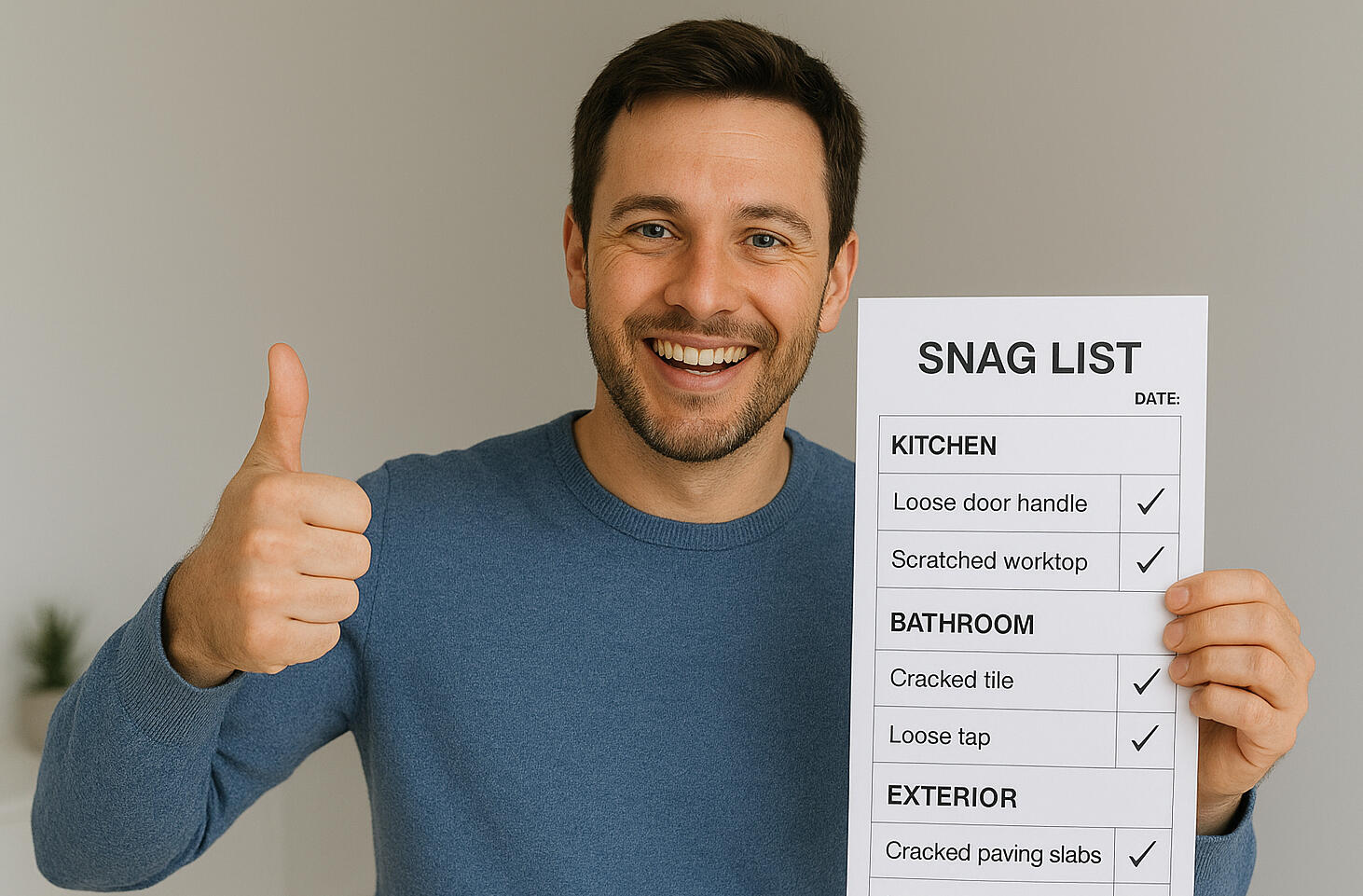
Take Control of Your Home Snagging
Professional snaggers want you to believe they’re the only option.The truth? You can do it yourself, quickly, confidently, and for a fraction of the price.QuickSnag gives you everything you need to protect your new home without draining your wallet.
The Story Behind QuickSnag

QuickSnag wasn’t dreamed up in some tech lab it started with my friend Paul.Paul had just moved into his new house.Like most of us, he’d poured just about every penny he had into the move.Boxes everywhere, takeaway dinners for a week and that mix of excitement and stress that comes with starting fresh in a new place.But almost as soon as he settled in, the problems started showing up.A door that didn’t close right. Paintwork that had been rushed.A loose fitting here, a cracked tile there. In other words: snags.Now, Paul’s not the type to ignore things, but he was stuck.He didn’t have the cash left to hire a professional snagging company, and he didn’t want to send his developer a messy list of half-written notes and random photos so his thoughts turned to self snagging, (He had a good eye for detail)What he needed was simple:Something easy to use, so he could just log what he saw.A way to add photos and details, without overcomplicating it.A professional document at the end, one that his developer would actually take seriously.And above all, something that didn’t cost a fortune.That’s where the idea for QuickSnag was born.We built this snagging software to be the tool Paul wished he had but couldn’t find.A no-nonsense way to record every snag, keep it all organised, consistent and with one click, turn it into a clean, formal report (PDF) to send straight to your builder.No fuss, no huge bill.It started as a solution for Paul, but quickly became clear it could help anyone moving into a new home.Because let’s be honest moving in is stressful enough!Sorting out snags shouldn’t add to it.And that’s what QuickSnag is all about: giving new homeowners confidence and control when it comes to self snagging their new home.
Snag List Software Features

All the features you need
Snag Search
Snag Filters
Guides to help you identify common snags
Realtime updates, update any snag quickly and easily
Secure sign in via email
Upload and store photos of the snag
Track open, in progress and closed snags
Prioritise snags so you get the fixes you need
No downloads required from the AppStore or Google Play
Works on all devices including mobile. (A WiFi or mobile network connection is required)
Create a PDF documents to hand to your developer or builder. (10 complete PDF's can be created)
Quick Snag is built for homeowners who want a smart app stoneware tool to record and share property snags.Easy Snag Issue LoggingRecord snags quickly with detailed information and photo evidence perfect for recording the issues in your home.Clear Snag Status TrackingSee which snags are new, in progress, or completed at a glance, no guessing.Straightforward Software InterfaceNo complicated screens, designed for ease of use on any device - no download required (Connection to internet via phone carrier or WIFI is required)
Snag Search and Filter
Search and filters help narrow down your snags. Great if you have a large snag list.
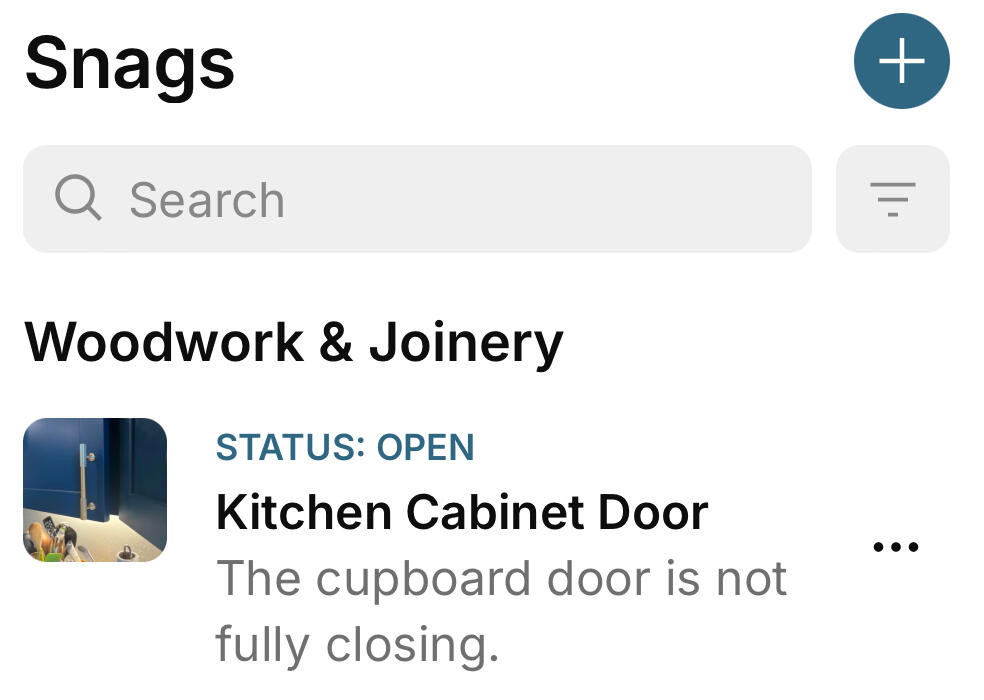
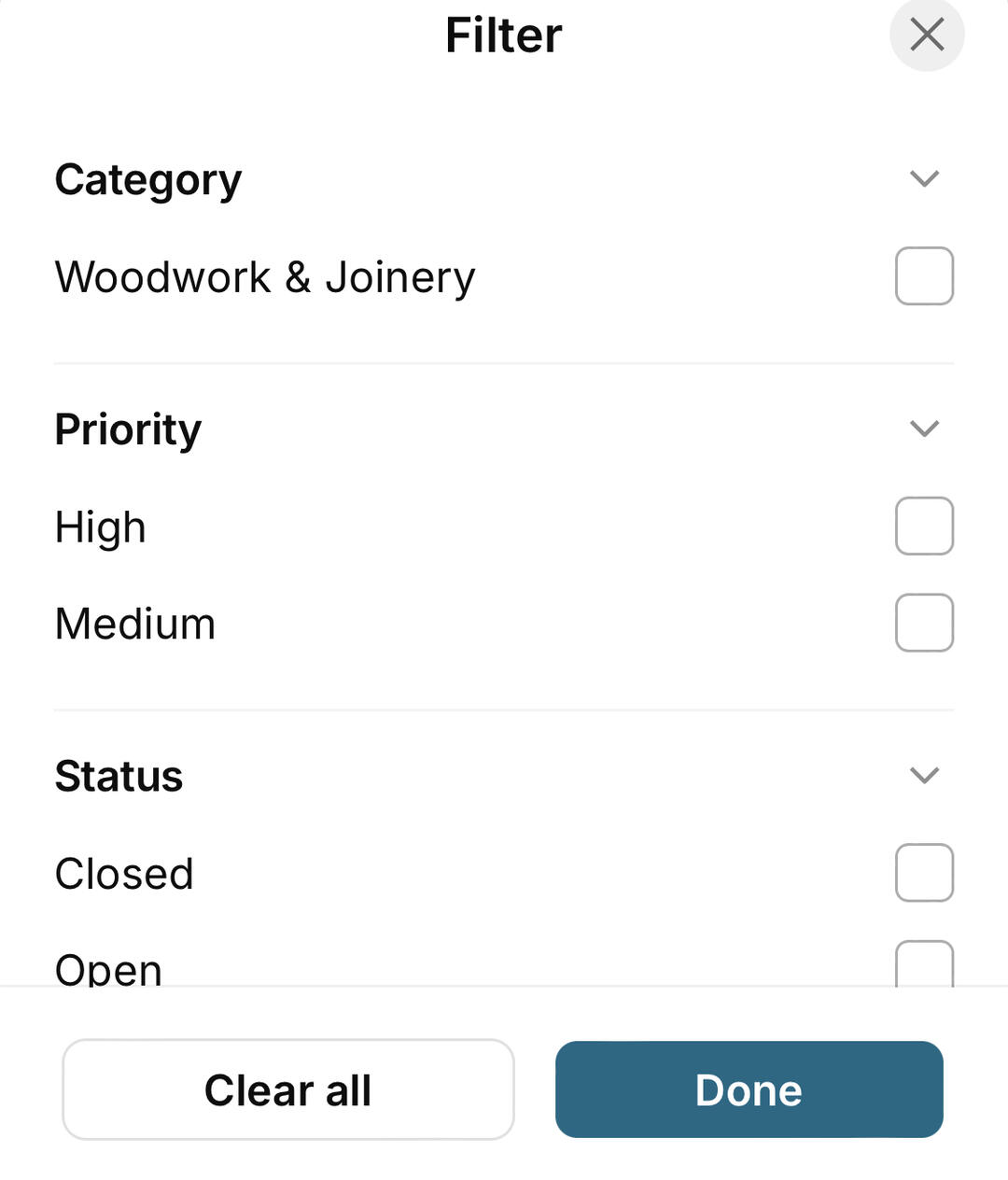
Snagging Guides
Using our comprehensive snagging guide to help you identify common snags around your home
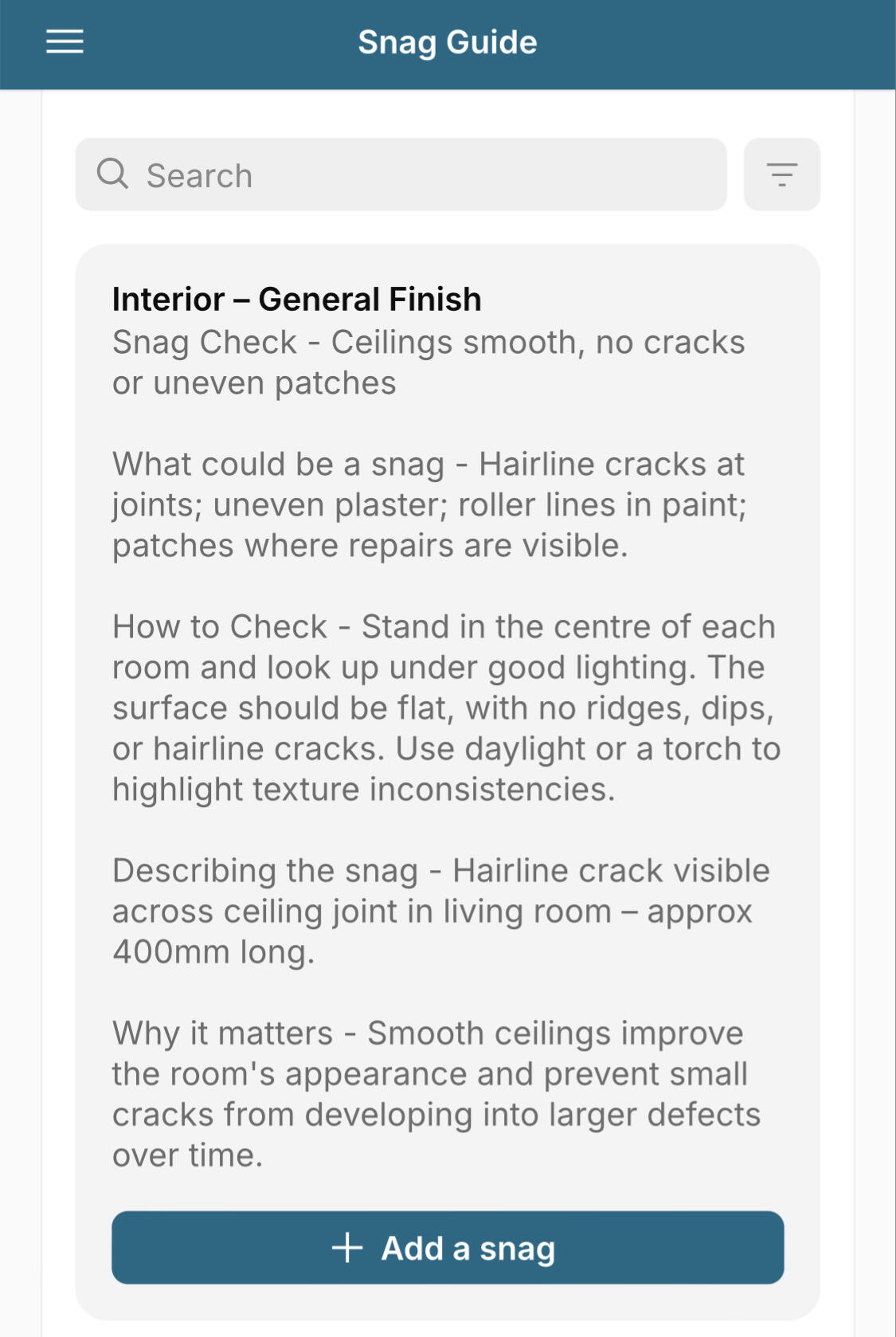
Realtime Snagging Updates
Quickly and easily update any snag in real time.
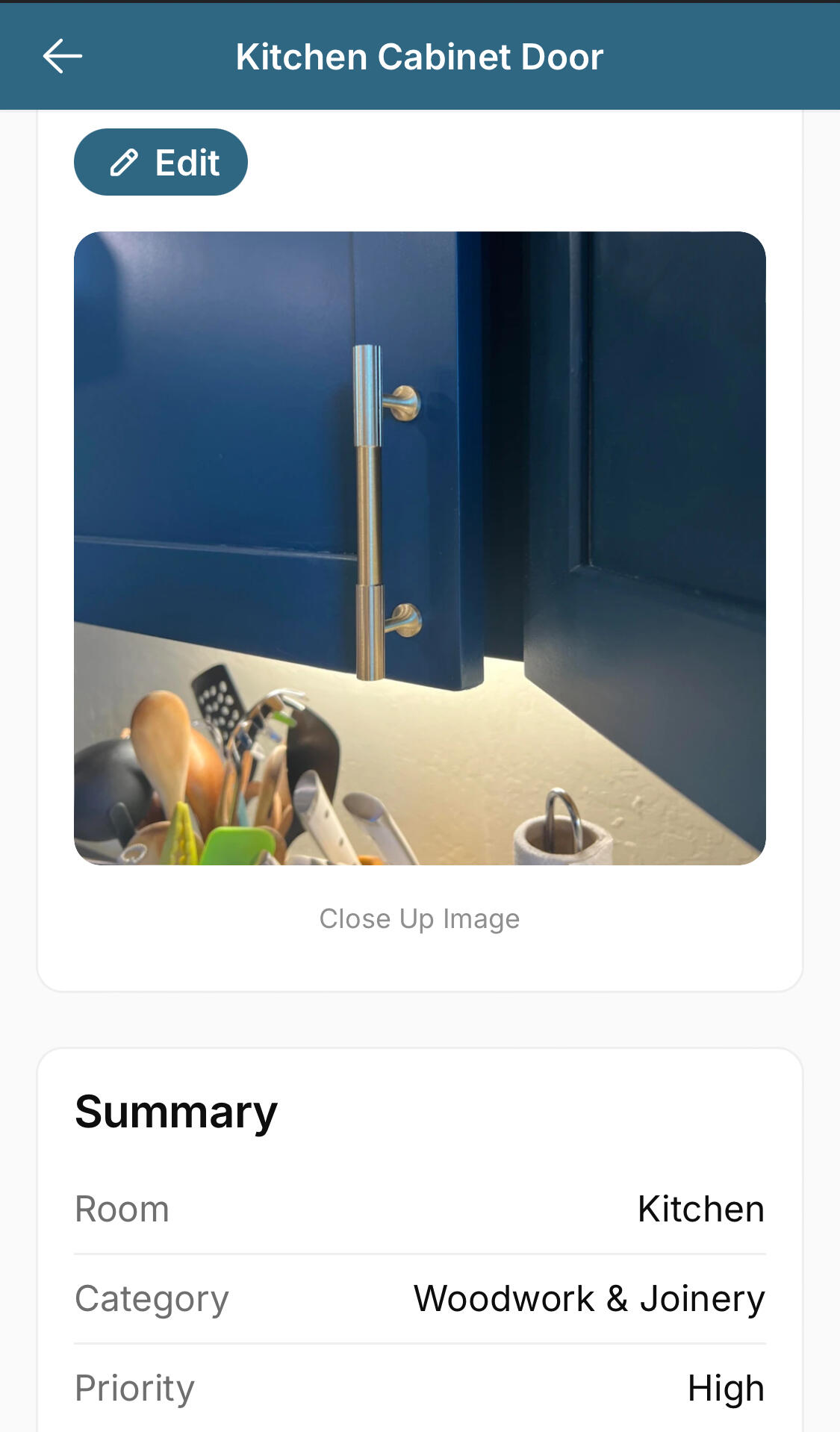
Snag List Progress Tracking
Track the progress of your snags
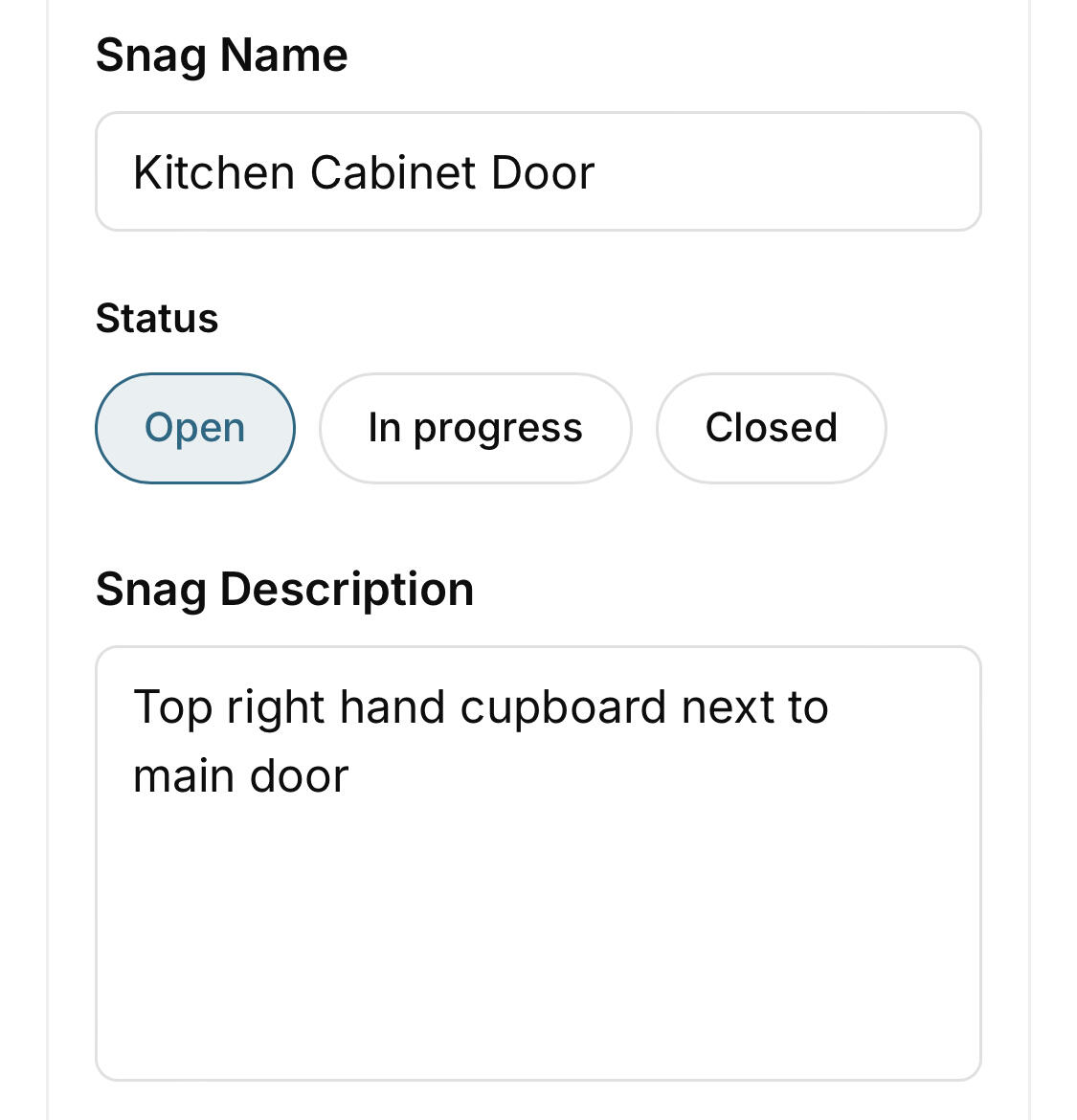
Snaglist Pricing

Pricing
Simple pricing makes sure you get the service you need.
£39 - Record and manage 50 Snags, Create 10 PDF reports, access for 90 daysNeed more snags, PDFs or just a bit longer, no problem.Add ons
- 30 extra days £10
- 25x Extra Snags £7
- 5x PDF £5
No long term contracts, payment made securely via stripe.
Quicksnag Benefits

The benefits of using snag list softwareQuickSnag is built for UK homeowners who need a faster, easier way to log, organise, track and create snagging reports to share with their builder, all from one simple online dashboard.You update progress directly from your phones, tablet or computer.Unlike hiring a professional snagging company which can cost £300+ QuickSnag gives you a professional easy to use solution for a fraction of the price.You can quickly and easily create a PDF document detailing all the snags to give to your builder.
FAQ’s for Quick Snag Software

How much does it cost?Price depends on how long you need the software for. Pricing starts from £25 Find out more about pricing.How do I pay?Online via stripe secure payment link.Is there any help you can give me ?Yes, there’s a guide to help you with many aspects of snagging your home.Should I hire a professional snag company?A professional snagging company can do the inspection for you, which is useful if you’d rather not be involved at all but it can be expensive and you may have to wait for availability.Our DIY snag service gives you the same type of structured process and checklists, so you can carry out the inspection yourself at your own pace.If you’re comfortable performing the checks yourself, you can save money and still get a thorough result.
If you’d rather hand the whole job over, a professional might suit you but most homeowners find our service gives them everything they needCan I create a PDF detailing all the snags to give to my builder?Yes, once you have completed all the snags you can create a PDF document to give to your builder. It’s easy and created by just a click of a button.How many snags can I add?Most people will never use more than 100 but you can add as many as you like.Can I add photos to support my findings?Yes, you can add two photos for each snag.
Join waiting listWe have increasing demand for this service please join our waiting list and we will let you know when spaces become available.Thanks
Snagging Tips
DIY Snag List vs Professional Snagging Company: Which is Right for You?
When Should You Do a Snagging Inspection? Homeowner’s Timeline
How to Prioritise Snags: What Really Matters
The Ultimate Guide to Snagging Software for DIY Homeowners
Final Walkthroughs How to Inspect Your Home Like a Pro
DIY Snag List vs Professional Snagging Company: Which is Right for You?When moving into a new home or completing a renovation, spotting construction issues early can save you time, money, and stress. This is where snagging comes in the process of identifying minor faults or “snags” before they become major problems. But should you tackle this yourself with a DIY snag list, or hire a professional snagging company? Let’s break it down.What is a DIY Snag List?A DIY snag list is exactly what it sounds like: a list of defects and issues in your new property that you identify yourself. It can include things like:
• Doors and windows that don’t close properly
• Paint or plaster imperfections
• Loose fittings or fixtures
• Minor leaks or water damage
• Uneven flooringCreating your own list is usually done with a software such as QuickSnag. This gives you a structured way to communicate issues to your builder or developer.Benefits of DIY Snagging• Cost-effective: The biggest advantage is that it’s free aside from your time.
• Flexible: You can inspect at your own pace, revisit areas, and prioritise what matters most to you.
• Learning experience: You become more familiar with your property, which can help you spot potential issues down the line.Limitations of DIY Snagging• Maybe less thorough: Without experience, it’s easy to miss subtle defects - Although QuickSnag has guides to help you spot and record common Snags
• No expert guidance: Some issues may have long-term consequences that only a professional may recognise.
• Time-consuming: Completing a full inspection can take several hours or days.What is a Professional Snagging Company?Professional snagging companies are experts in inspecting new or renovated homes. They provide detailed snagging reports, often with photos and recommendations, and may use checklists based on industry standards. These companies aim to give you peace of mind and ensure all issues are identified before you move in or accept the property.Benefits of Hiring Professionals• Expert knowledge: Professionals know what to look for, including hidden defects that could become expensive later.
• Comprehensive reporting: They provide structured, clear reports that can strengthen your case with the builder.
• Time-saving: The inspection is done efficiently and professionally, often with support for follow-up actions.Limitations of Professional Snagging• Cost: Professional inspections can range from a few hundred to over a thousand pounds depending on the property size.
• Scheduling: You need to work around their availability.
• Potential overkill: For smaller or simpler projects, a professional may identify issues you consider minor or irrelevant.DIY vs Professional: Making the ChoiceUltimately, the choice depends on your comfort level, budget, and the size or complexity of the property. Many homeowners find that a DIY snag list works well for smaller projects or straightforward homes, especially when paired with good software such as Quicksnag.However, if you’re purchasing a large property, or want extra assurance, a professional snagging service can provide peace of mind.Why DIY Often Makes SenseFor many homeowners, a DIY approach strikes the perfect balance between cost and control. With the right snagging software enabling you to create a comprehensive snag list, paired with photos, snag descriptions and a systematic approach you can effectively document snags and communicate them to your builder without the expense of hiring a professional.Plus, you gain insight into your home that can be invaluable for maintenance and future projects.SummaryDIY snag lists are accessible, flexible, and budget-friendly, while professional snagging offers expertise and potential thoroughness.Knowing the difference helps you choose the approach that fits your needs, ensuring your home is safe, sound, and ready for you to enjoy.The NHBC has some useful documents including a new homes checklistThey also publish their latest UK property standards
When Should You Do a Snagging Inspection? A Homeowner’s TimelineBuying a new home or completing a major renovation is exciting but it can also come with hidden challenges.Minor defects, or “snags,” are almost always part of the process. Catching these issues early can save you time, money, and frustration. But when exactly should you do a snagging inspection? Here’s a homeowner’s timeline to guide you.During Construction (Optional Early Checks)If your property is still under construction, some homeowners like to perform early checks. These are usually informal and focus on spotting obvious issues before walls, floors, or finishes are completed.What to look for:
• Structural alignment (doors, windows, walls)
• Early plumbing or electrical visible work
• Any visible cracks or damage in materialsWhy it matters:
Early observations give your builder a chance to fix things before finishes are applied, which is often cheaper and faster.Pre-Handover InspectionThe most crucial time for a snagging inspection is right before you officially take ownership of your home. At this stage, the builder has finished most work, and it’s easier to identify defects that may affect your daily living.Typical timeline:
• Usually a week or two before completion
• Coordinate with the builder to ensure access to all areasWhat to check:
• Doors and windows (alignment, locks, handles)
• Flooring and tiling (cracks, uneven surfaces)
• Walls and ceilings (paint, plaster imperfections)
• Fixtures and fittings (sinks, cupboards, showers)
• External works (driveways, fencing, garden levels)Why it matters:
This is your last chance to request fixes before moving in or completing the handover. A detailed snag list helps ensure your home is delivered to a high standard.Post-Move-In SnaggingEven after moving in, it’s common to discover minor issues that weren’t apparent during the pre-handover inspection.Typical timeline:
• Within the first 1–3 months of living in your homeWhat to check:
• Plumbing and heating performance
• Electrical outlets and appliances
• Minor settling cracks or flooring adjustments
• Doors, windows, and cabinetry after regular useWhy it matters:
Builders often provide a warranty or defect liability period. Identifying issues early ensures they are addressed under the warranty rather than out of pocket.Quick Tips for Timing Your Inspection1. Plan ahead: Know the estimated completion date and schedule inspections accordingly.2. Don’t rush: Allow time for a full walkthrough at least a couple of hours for an average property.3. Document everything: Take photos and notes to support your snag list using Quicksnag4. Revisit if necessary: Some issues only appear after use, so a follow-up check can be useful.SummaryThe right timing for a snagging inspection is all about balance: early enough to catch defects before it’s costly to fix, but late enough to see the finished work. Most homeowners benefit from a pre-handover inspection, followed by a post-move-in check during the first few months.With a clear timeline and structured approach, snagging becomes a manageable process ensuring your home is safe, comfortable, and delivered to the standard you expect.
How to Prioritise Snags: What Really MattersWhen moving into a new build or completing a renovation, it’s common to discover a number of minor defects or “snags.”Not all snags are created equal some can have long-term consequences if ignored, while others are purely cosmetic. Knowing how to prioritise snags helps you address the most important issues first and ensures your home is safe, comfortable, and delivered to the right standard.Understand the Types of SnagsBefore prioritising, it’s helpful to classify snags into categories:• Safety-related defects: Anything that could put you or others at risk. Examples: faulty electrical outlets, loose stair railings, slippery floors.• Functional defects: Issues that affect how the property works. Examples: doors that don’t close, leaks in plumbing, windows that don’t open.• Cosmetic defects: Minor imperfections that affect appearance but not performance. Examples: paint smudges, small scratches in flooring, misaligned tiles.• Warranty/structural concerns: Problems that may worsen over time. Examples: cracks in walls, damp, foundation settling.Safety Comes FirstSafety defects are always top priority. These are issues that could cause injury or property damage if left unaddressed.Examples:
• Exposed wires or faulty sockets
• Loose handrails or balustrades
• Unstable flooring or decking
• Gas or water leaksAction: Notify your builder immediately and request urgent resolution.Address Functional Defects NextOnce safety issues are resolved, focus on functional snags. These affect the usability of your home and can become more frustrating over time.Examples:
• Doors or windows sticking or not closing properly
• Faulty plumbing or taps
• Broken light switches or appliances
• Heating, ventilation, or air conditioning issuesAction: Create a detailed snag list with photos to share with your builder for prompt rectification.Cosmetic Issues Can WaitCosmetic defects are lower priority because they do not impact safety or functionality. However, they’re still worth documenting, especially if the property is new and under warranty.Examples:
• Uneven paint or wallpaper
• Minor scratches on surfaces
• Small tile chipsAction: Include these in your snag list, but they can often be addressed in a second visit or as part of ongoing maintenance.Consider Long-Term ConcernsSome snags may seem minor now but can worsen over time, leading to structural or expensive problems.Examples:
• Hairline cracks in walls or ceilings
• Signs of damp or water ingress
• Floor unevenness that could worsenAction: Flag these for monitoring or early repair. Professionals can often give guidance on whether immediate action is required.Tips for Prioritising Your Snag List1. Use a simple ranking system: High = Safety/structural
Medium = Functional but usable
Low = Cosmetic.
You can do this in Quicksnag2. Take photos: Document defects to help your builder understand severity.3. Group similar items: Easier for the builder to tackle related issues together.4. Focus on impact: Ask yourself, “Does this affect safety, usability, or long-term integrity?”SummaryPrioritising snags ensures that your new home is safe, functional, and enjoyable to live in from day one. Safety-related issues always come first, followed by functional defects, long-term concerns, and finally cosmetic imperfections.By taking a structured approach, you’ll make your snagging process more efficient, reduce stress, and ensure your builder addresses the issues that matter most.
The Ultimate Guide to Snagging Software for DIY HomeownersCompleting a new build or renovation is exciting but spotting every defect before moving in can be overwhelming.Snagging software can simplify the process, helping homeowners create detailed, organised snag lists quickly and efficiently. In this guide, we’ll explore what snagging software is, why it’s useful, and how DIY homeowners can make the most of it.What is Snagging Software?Snagging software or apps are online digital tools designed to help homeowners, builders, and property managers identify, track, and resolve defects in a property.Instead of relying on paper checklists or spreadsheets, you can log issues directly on your device, add photos, and generate reports.Key features often include:
• Pre-built checklists for common defects
• Photo and video attachments
• Notes and priority settings for each snag
• Exportable reports for builders to work from
• Progress trackingWhy DIY Homeowners Should Consider Snagging SoftwareEven if you’re not hiring a professional, snagging software can provide huge benefits:1. Organisation: Keep all your snags in one place, avoiding lost notes or forgotten issues.2. Efficiency: Quickly capture defects with photos and notes on your smartphone or tablet.3. Professional-Looking Reports: Generate PDFs to send to builders, showing a structured, easy-to-follow list of snags.4. Prioritisation: Mark items by urgency or type (safety, functional, cosmetic) to tackle the most important issues first.5. Time-Saving: Reduce repeated walkthroughs by logging everything digitally during your inspection.Top DIY Features to Look ForWhen choosing snagging software such as Quicksnag for your home, consider these features:• Customisable Checklists: Adapt checklists to your property type or project.• Photo & Video Capture: Attach images for each snag for clear communication with your builder.• Report Exporting: Generate a PDF document to share with your builder.• User-Friendly Interface: Easy navigation is essential for homeowners who aren’t tech experts.Popular DIY Snagging ToolsWhile there are professional snagging platforms, we recommend Quicksnag with its simple interface, which allows photo attachments, descriptions, priorities and PDF creation. plus much moreTips for Using Snagging Software Effectively1. Walk the Property Methodically: Room by room, floor by floor.2. Photograph Every Issue: Capture context, not just the defect.3. Prioritise Snags: Mark urgent vs cosmetic defects to make the report actionable.4. Review & Export: Generate your PDF or spreadsheet before submitting to the builder.SummaryDIY snagging doesn’t have to be stressful or time-consuming. Using snagging software helps homeowners stay organised, communicate clearly with builders, and ensure no defect goes unnoticed.With the right tools and approach, you can confidently tackle snagging yourself saving money while maintaining control over your home’s quality.
Final Walkthroughs: How to Inspect Your Home Like a ProMoving into a new build or recently renovated property is exciting but it’s also the perfect time to spot defects or “snags” before they become bigger problems.A final walkthrough can be done before you officially move in or shortly after you’ve started living in your home. Understanding both approaches ensures you catch issues early and get them fixed efficiently.Pre Move In WalkthroughWhy it matters: Inspecting before moving in allows you to identify defects while the builder still has full access and before furniture or belongings get in the way.Focus areas:
• Doors and windows: opening, closing, and locking
• Floors and walls: scratches, cracks, or uneven surfaces
• Fixtures and fittings: taps, showers, cabinets, appliances
• Electrical: switches, outlets, and lighting
• Heating, ventilation, and cooling systems
• Exterior: roofing, gutters, driveways, patios, fencing, and gardensTip: Take photos and make detailed notes using QuickSnag. Prioritise safety and functional defects first, then cosmetic issues.Post Move In Snag InspectionEven after moving in, some snags may only become apparent with everyday use. Small leaks, door alignment issues, or appliance quirks can appear after a few weeks.Focus areas:
• Plumbing and heating systems under regular use
• Doors, windows, and cabinetry after repeated opening and closing
• Settling cracks or flooring adjustments
• Any defects that affect daily comfort and usabilityTip: Keep a running snag list and photos, and contact your builder promptly if new issues arise.Prioritising SnagsWhether pre or post move in, focus on what matters most:1. Safety issues: loose railings, exposed wires, gas or water leaks2. Functional defects: doors/windows sticking, leaks, faulty heating or plumbing3. Long-term concerns: hairline cracks, damp, structural settlement4. Cosmetic defects: paint smudges, minor scratches, small misalignmentsTip: Use a simple ranking system (High, Medium, Low) to help builders address critical items first.Documenting and Reporting Snags• Record all issues in a structured list or snagging software Quicksnag
• Include photos for clarity
• Submit your snag list to the builder promptly
• Follow up to confirm repairs are completed and track them in QuicksnagSummaryA final walkthrough is essential whether you inspect before you move in or shortly after settling into your home. Pre move in inspections help catch issues early, while post move in checks ensure that no defect goes unnoticed in everyday use.With preparation, methodical inspection, and clear documentation, you can ensure your home is safe, functional, and enjoyable from day one.
Thanks!We will be in contact soon.
